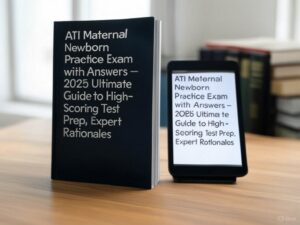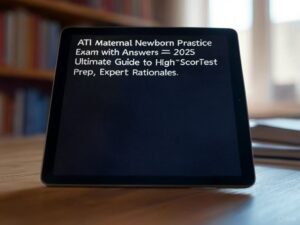-
Extensive practice questions with accurate answers for the 2025 exam
-
Expert rationales to enhance your understanding and test-taking skills
-
Covers key maternal-newborn topics: prenatal, labor, newborn, and postpartum care
-
Designed for high-scoring preparation and clinical readiness
-
The definitive resource for nursing students aiming to excel
Preview
1. Nonstress Test (NST) Purpose
Question:
A nurse is performing a nonstress test (NST) on a client who is at 41 weeks of gestation.
The client asks what the purpose of the test is. Which of the following responses should
the nurse provide?
A. “This test will determine if you will likely deliver within the next week.”
B. “This test will help determine if your baby is healthy.”
C. “This test can see how your baby responds when you have contractions.”
D. “This test will determine if your baby’s lungs are mature.”
Correct Answer: B
Rationale: The NST evaluates fetal well-being by assessing the fetal heart rate in
response to fetal movement. A reactive test suggests the fetus is well oxygenated and
neurologically intact.
• A is incorrect: The NST doesn’t predict the timing of labor.
• C is incorrect: That describes a contraction stress test (CST), not an NST.
• D is incorrect: Fetal lung maturity is evaluated through amniocentesis, not an
NST.
2. Prolapsed Umbilical Cord Intervention
Question:
A nurse is caring for a client who just had a spontaneous rupture of membranes. The
nurse observes fetal bradycardia on the FHR tracing and a prolapsed umbilical cord.
Which of the following actions should the nurse take first?
A. Place the client in an extreme Trendelenburg position
B. Increase the IV fluid infusion rate
C. Manually apply upward pressure intravaginally on the presenting part
D. Administer 8 to 10 L/min of oxygen via a nonrebreather face mask
Correct Answer: C
Rationale: The priority action is to relieve pressure on the prolapsed cord to prevent
fetal hypoxia. Manually lifting the presenting part off the cord maintains fetal perfusion
until delivery.
• A is helpful but not the first priority.
• B and D are supportive measures but do not immediately address the cause of
the bradycardia.
3. Hepatitis B Vaccine Contraindication
Question:
A nurse is assessing a client before administering the hepatitis B vaccine. Which of the
following allergies should the nurse identify as a contraindication to receiving this
vaccine?
A. Shellfish
B. Gelatin
C. Baker’s yeast
D. Eggs
Correct Answer: C
Rationale: Hepatitis B vaccine is contraindicated in individuals with a severe allergy to
baker’s yeast, as it is used in the vaccine’s production process.
• A is associated with iodine-based contrast media, not this vaccine.
• B is linked to the MMR vaccine.
• D is a contraindication for the influenza vaccine made with egg proteins.












Reviews
There are no reviews yet.